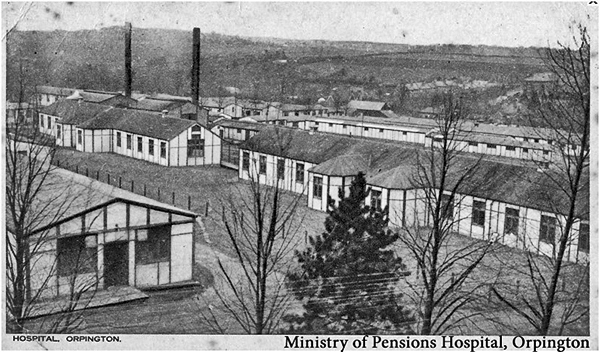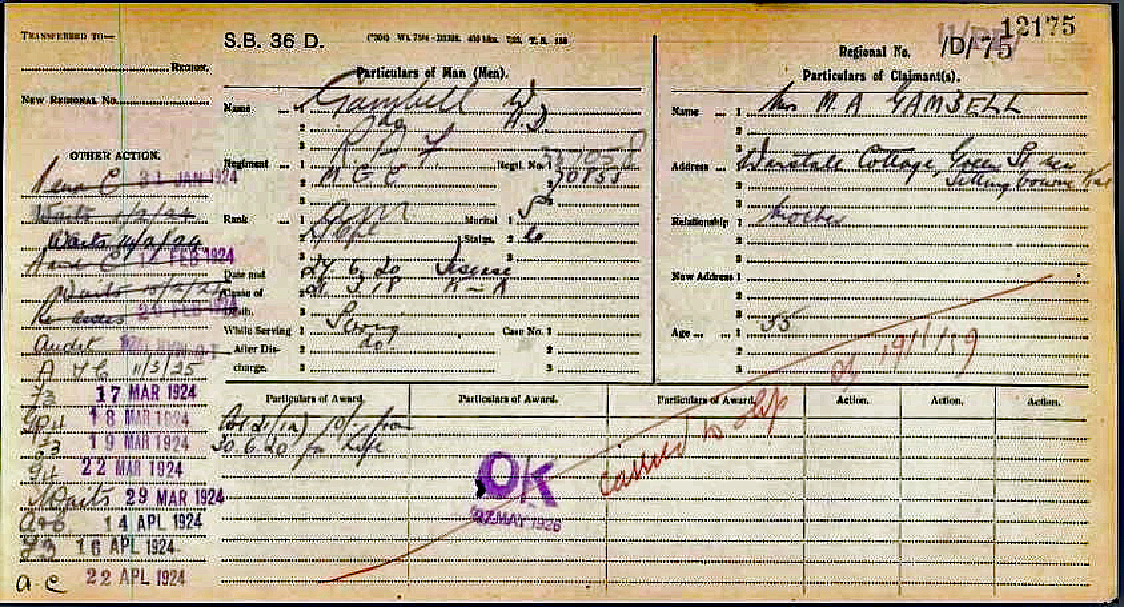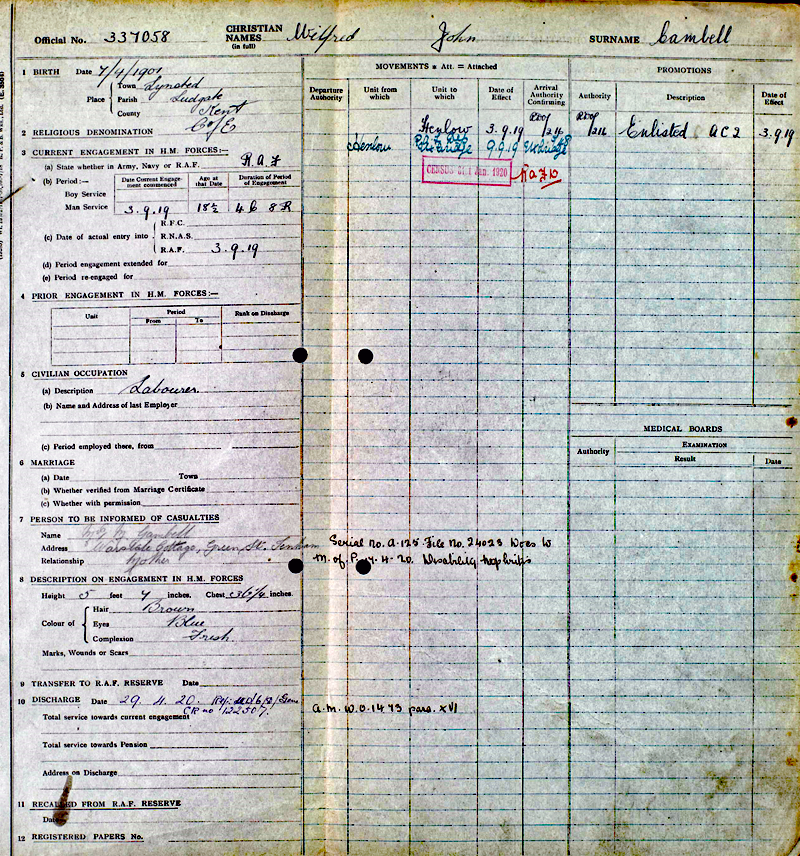First World War Project
Wilfred John GAMBELL (of Lynsted)
b. April 1901 Air Craftsman II |
Since the publication of "They Shall Grow Not Old" by the Lynsted with Kingsdown Society on 10 November 2018, further records have become available. Notably the Royal Air Force (RAF) have begun to place on-line service records of those who served in the Royal Flying Corp and the RAF. This has enabled us to discover more about Wilfred's short life.
Wilfred has proved a bit of an enigma and, to a certain extent his records have only been found by chance. Inaccuracies in record keeping and mis-spelling of his name has sent us down many a blind alley. Even the latest records have added another mis-spelling of his surname.
Wilfred was born on 7 April 1901 at Ludgate Farm, Lynsted, the youngest of David and Mary Ann Gambell's three sons. Wilfred's oldest brother was Herbert, whose story we told earlier in the book; his other brother Sydney survived the war.
By the time of Wilfred's christening in Lynsted Church on 28 April 1901, we meet the first mis-recording of his name. The christening records have record his name, and that of his parents, as "Gambrill". The 1911 Census has been transcribed incorrectly, giving Wilfred's middle initial as "G" rather than "J". The record itself is clear that the initial is "J". At this time Wilfred was living at Radfield Cottages, Bapchild. Towards the end of the war the Gambell family moved to Wanstall Cottages, Greenstreet, Lynsted.
Wilfred appears on the Lynsted Memorial as serving in the Royal Air Force (RAF). Our original research was unable to confirm any details of his service. He certainly did not appear in the RAF Muster list. We knew that, by rights, Wilfred would not have been eligible for call up until his 18th birthday in April 1919. However, we knew that both his older brothers had joined up under age and there was no knowing whether he had followed in their footsteps.
Through chance, we came across RAF records for a Wilfred John "Campbell", which proved to be a third mis-recording of the surname.
These discovered records confirmed his date of birth as 7 April 1901 in Ludgate, Lynsted, Kent. It also recorded his mother as M "Cambell". We now know that Wilfred worked as a labourer prior to his enlistment when he stood 5ft 7 inches tall, with brown hair and blue eyes, and marked out as having a very good character.
Wilfred enlisted on 3 September 1919. Records do not show whether this was conscription or voluntary*. We now know that Wilfred's service in the RAF started at Henlow, Bedfordshire, aged 18 years and 5 months. His service number was 337058 and his rank Air Craftsman 2 (AC2). The rank of AC2 was introduced to the RAF in January 1919, replacing the rank prefixes of "Air Mechanic", "Private" and "Clerk" that had been introduced under Air Memorandum No 1 in March 1918.
Henlow was chosen as a military aircraft repair depot in 1917. Originally a repair depot for aircraft from the Western Front. The Station officially opened on 18 May 1918.
Just 6 days after enlistment, Wilfred was posted to Uxbridge on 9 September 1919. Around this time RAF Uxbridge had become increasingly busy since becoming No. 1 Recruitment Training Depot in August 1919. The station had been split to form two new RAF stations, Uxbridge and Hillingdon. The RAF School of Music moved to RAF Uxbridge from Hampstead in September 1919.
Unfortunately, on 17 April 1920, after just 8 months of service Wilfred was admitted to the Ministry of Pensions Hospital in Orpington** suffering from nephritis. On 29 April 1920, just twelve days after his admission, he was officially discharged from the RAF due to disability. Two months later, on 27 June 1920, Wilfred died. His death certificate records his surname under a fourth variation — "Gamble". Wilfred was recorded as an "Army Pensioner - General Labourer" and his cause of death was nephritis.
Wilfred's death is not acknowledged by the Commonwealth War Graves Commission. Although his death occurred during the qualifying period (4 August 1914 to 31 August 1921), his was not an illness caused or exacerbated by military service. Wilfred had not entered a "theatre of war" so he was not eligible for service medals.
Investigations are ongoing to find Wilfred's final resting place.
His death was announced locally:
| East Kent Gazette of 17th July 1920 |
| DEATHS: GAMBELL – On June 27, 1920, at Orpington Ministry Pension Hospital, Wilfred John Gambell, youngest son of Mr and Mrs David Gambell, Greenstreet, aged 19 years. |
On 30 June 1920, for the loss of 2 sons, Wilfred and Herbert, Mary Gambell was awarded 10 shillings (50p) a week for life. In today's money this amounts to approximately £25 a week.
* The end of Conscription
An exact date for the end of conscription into the services is difficult to pin down.
In November 1918, the Secretaries of the Local Government Board and the Ministry of National Service made the following statement:
Questions have been raised in connection with the announcement by the Government that all recruiting under the Military Service Acts is to be suspended as to the position of men who have been granted by tribunals' conditional certificates of exemption from military service.
While recruiting under the Military Service Acts has been suspended, these Acts remain in force in case necessity should arise for bringing them again into operation. A man, therefore, who holds a conditional exemption and who ceases to fulfil the conditions on which the certificate was granted would be liable to be called up for service in the event of a resumption of recruiting under the Military Service Act, subject to the right (under new regulations for tribunals about to be made) of applying for renewal of exemption within seven days of the issue of a public notice of the resumption of recruiting under the Military Service Acts.
The same considerations apply to voluntarily attested men who have been granted conditional exemption by a tribunal.
The General Election held on 14 December 1918 (known as the "Khaki Election") was won on 3 pledges:
- the Kaiser be put on trial
- a payment by Germany of an indemnity
- the abolition of conscription
By 1920 not one of the pledges had come to fruition. The House of Commons Hansard of 20 May 1920 recorded the following:
Mr. Lunn asked the Secretary of State for War and Air whether the Military Service Acts, 1916 to 1918, have lapsed or have been repealed; and, if not, whether the Government will introduce immediately a Bill for their repeal?
Mr. Churchill: THE ANSWER TO THE FIRST PART OF THE QUESTION IS IN THE NEGATIVE. With regard to the latter part, it is not considered necessary to introduce a Bill repealing the Military Service Acts, as orders have been issued for all conscripts to be released, and the Military Service Acts will automatically lapse on the official termination of the war.
At that time the "official termination of the War," had not been determined. Although the Treaty of Versailles (the Peace Treaty) had been signed in on 28 June 1919. The British ratified the Treaty on 27 November 1919 when the King agreed that the official end of the war would be the date the Treaty was signed. Other Allied Countries (but no the USA) ratified the Treaty in 1920.
** The Ministry of Pensions Hospital Orpington

Wilfred's place of death was the Ministry of Pensions Hospital in Orpington. The hospital was originally the Ontario Military Hospital; inaugurated by the Government of Ontario in February 1916 for the care of Canadian troops in camps in England or actively engaged at the front in France. The 70-acre site was chosen as it lay 15 miles from London and near the main South-Eastern railway line from Dover to Folkestone. Although the majority of the patients were Canadian, troops from Britain and the British Empire - Newfoundland (then a British colony), Australia, New Zealand - as well as from the Allied forces were also received. In September 1917, the Hospital was reorganised and renamed the No. 16 Canadian General Hospital.
By January 1919 more than 25,000 wounded troops had been treated at the Hospital. Only 182 (less than 1%) died; most are buried in the 'Canadian Corner' of the nearby All Saints' Church graveyard.
The Hospital was finally demobilised on 20 September 1919, when it came under the control of the Ministry of Pensions.
Service Record No.1 (click image for larger image)
Service Record No.2 - Conduct Sheet

Pension Record



 World War 1 Pages
World War 1 Pages